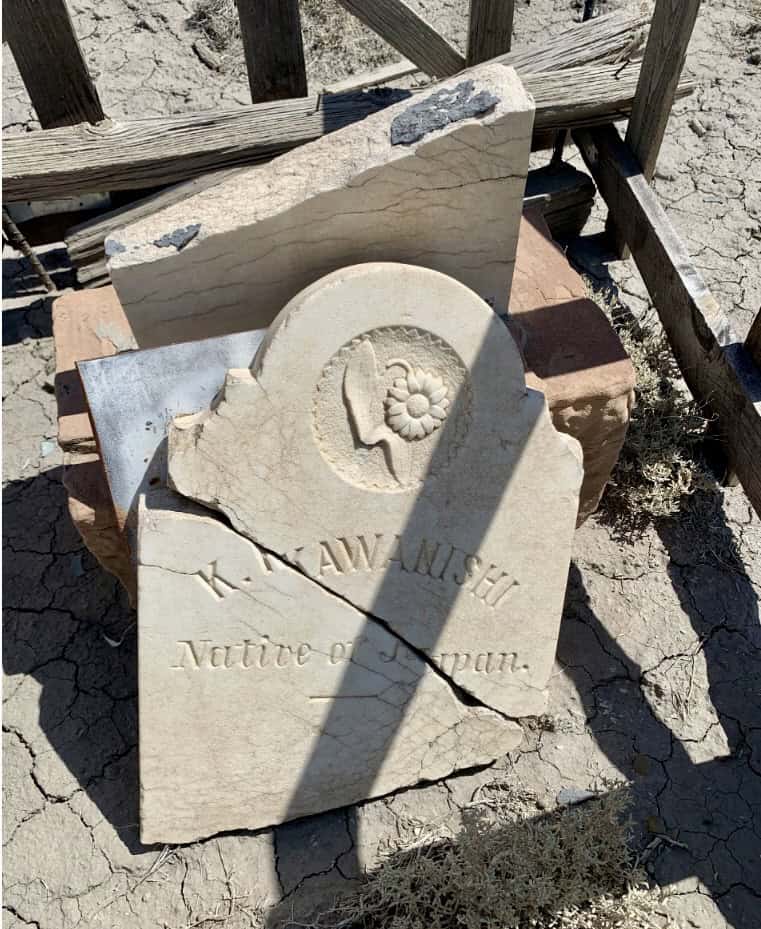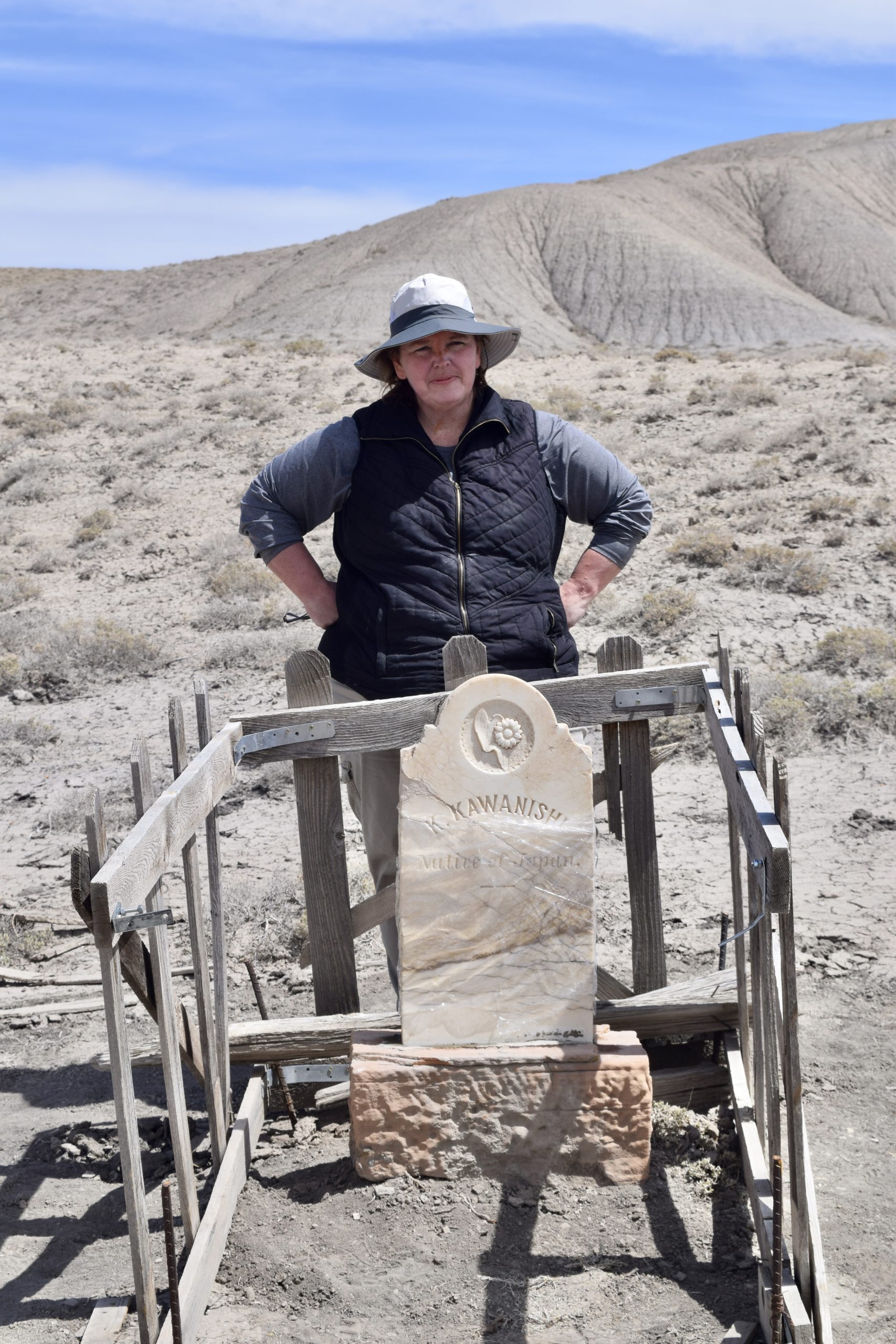Some information may be outdated.
Little is known about K. Kawanishi. Sketchy records from the turn of the century indicate that he immigrated to the United States from Japan in 1900 in his early 20s. He lived in a boarding house in Thompson Springs, Utah, while working for the Denver & Rio Grande Western Railroad Company. He was married and, sometime between 1900 and 1905, he died and was buried in a lonely place in northern Grand County, the site still marked by a beautifully carved marble tombstone with his name inscribed under a decorative flower and above the words “Native of Japan.”
Cemeteries Program Manager for the Utah Division of State History Amy Barry learned that much from context and research into historic census records. It’s not known how Kawanishi died, or why he was buried in that spot.
“The only thing I will say about how Kawanishi is situated is that he’s facing the train,” Barry said. She has spent significant time at the site in recent weeks, working to properly record it and repair the damaged headstone.


The Bureau of Land Management first took note of the tombstone in 1993, when it was observed during documentation of an old narrow-gauge railroad that was later abandoned in favor of a standard-width line. For years the tombstone lay cracked in three pieces. Over the past several weeks, Barry cleaned and restored the broken pieces in her lab in the Salt Lake City area. This week, officials from the Moab BLM office, Tara Beresh, the curatorial and collections manager for the Moab Museum, Edith Mitko, who has served as the state director of Asian Affairs, and several others joined Barry as she brought the pieces back to the site and mortared them together in place. The group hiked across desert scrub to reach the spot and watched as Barry removed clamps holding the pieces in place and mixed mortar to fill cracks in the marble.
She thoughtfully rationed pigment into the mortar to match the color of the marble. The cleaning agent used on the stone will lighten it over time, and the wet mortar is darker than it will be when it dries, making both the colors moving targets. Once she had the right mix, she donned latex gloves and started packing it into the cracks.
“I tend to just do everything by hand, because I can feel it better,” Barry said as she worked.

There’s evidence that someone has cared for the headstone in modern times: a repair attempt cementing the marble headstone to its sandstone plinth was done in recent decades, and a fence structure around the stone was rebuilt, likely in the last five to 10 years. Barry noted that the cement, while well-intentioned, will actually damage the marble in the long run. She explained with fluency the chemistry of weathering, materials reacting to each other, and the substances and techniques she uses to safely and successfully preserve headstones. She uses federal standards—techniques that have been lab-tested and will not damage the stone. Barry offers workshops and demonstrations around the state on correct methods for repair and preservation of headstones.
Why now?
Barry manages a database that tracks individual gravesites around the state. When she started with the Division of State History, the database was only available organized alphabetically. She set out to put it into a map format, a project that ended up taking about two and a half years. The Kawanishi site was the last coordinate she mapped, and the site was compelling to her: It’s a rare physical artifact that tells the story of Japanese laborers in Utah—a story that’s been difficult to tell because of the scarcity of such objects.
Barry worked with the BLM, secured the funds needed for the conservation materials, and found out what she could about Kawanishi. He’s documented on two census records from 1900, both the federal census and one conducted by a Japanese labor agent in Salt Lake City, which Barry trusts more: the federal census, she noted, shows a casual racism in that it lists all Japanese workers as servants of the section foremen and gives all of them the same birth month. Kawanishi does not appear on 1910 census records, suggesting that he died sometime between 1900 and 1910—Barry puts the date in the earlier half of the decade, based on the style of the headstone.
Poor record keeping means the rest of the story can only be guessed at. For example, the flower at the top of the headstone piques interest. Both cherry and lotus blossoms are symbols of Japan; it’s possible the flower is meant to be one of these. Barry also noted that language barriers may have prevented Kawanishi’s friends from conveying a more specific request than a flower.
While the details of Kawanishi’s life are a mystery, the grave is a powerful illustration of a larger story about immigrants and labor in the western U.S.
Railroads and racism in the U.S. and Grand County
The narrow gauge Denver & Rio Grande Western Railroad in Grand County was built between 1881 and 1883.
“At 720 miles in length, it was said to be the longest narrow-gauge track in the world,” according to Richard A. Firmage’s 1996 “A History of Grand County.”
Railroad companies were busy constructing transportation lines across the United States for much of the second half of the nineteenth century. To fill labor needs, companies recruited immigrants, notably from China; many Chinese immigrants were also already in the country around mid-century, having joined in the gold rush in California in the 1840s. Even after a rail line was completed, workers were still needed for ongoing maintenance. There were maintenance hubs and sidings—places where trains could be loaded, unloaded, or stored—at regular intervals along the track. According to Firmage, populations of Chinese, Japanese, Italian, and Greek people, as well as Black Americans, lived in the small towns supported by the railroad in Grand County, beginning in the late 1800s and continuing into the 1910s. When the standard-gauge tracks were completed in 1890, the narrow-gauge track was abandoned, stranding and eventually withering some of the small towns on its route; many of the residents left the area.
Meanwhile, anti-Chinese sentiment—especially in California—festered for decades, with some blaming Chinese laborers for depressed wages. In 1882, Congress passed the Chinese Exclusion Act, which banned entry to the United States to Chinese immigrants for the next 10 years. Many Chinese people already in the U.S. left under pressure from pervasive racism. Railroad companies still needed workers, though, and began recruiting immigrants from other countries, notably Japan.
It was in this context that K. Kawanishi immigrated to the U.S. and got a job with the railroad. Shortly after he died, anti-Asian sentiment in the U.S. carried exclusionist policies even further. In 1907, what became known as the Gentlemen’s Agreement between the U.S. and Japan informally established that the U.S. would not place restrictions on Japanese people already in the U.S., and Japan would not allow emigration to the United States. This was followed in 1924 by the National Origins Act, which banned immigration from Asia entirely. A form of that policy persisted up until the 1965 Immigration and Nationality Act.
Another historic site in Grand County attests to the continuation of anti-Asian sentiment in the U.S. In 1942, a camp that had been constructed to house members of the Civilian Conservation Corps was repurposed as an isolation center for Japanese Americans during World War II. The Moab Museum is planning to look at that history in an exhibit next year; the new Utahraptor State Park, which encompasses the Dalton Wells site, will have some interpretive material on it as well.
Over the past few years, racism and violence against Asian Americans has been on the rise—extreme incidents, like mass shootings, covered in the national media are tragic instances in the trend.
Mitko, who in addition to her role as the state director of Asian Affairs has also served in leadership roles for organizations that promote minority cultures, thanked the group for attending, and thanked Barry and the Division of State History for caring about the site. Especially in light of the increase in racism in recent years, the recognition of the site was very meaningful, she said.
Barry spritzed the mortar with water and wrapped it tightly in plastic wrap to keep it from drying too fast, which could cause it to shrink more and leave gaps in the crack. BLM officials would return later to remove the plastic wrap.
“The BLM cannot thank the Utah Division of State History enough for making this happen,” said Lori Hunsaker, archaeologist for the Moab BLM Field Office. Barry said she is honored to have been part of preserving this piece of history.
“This is just one thing to say ‘hey, Japanese railroad workers were here,’” Barry said.
Appreciate the coverage? Help keep local news alive.
Chip in to support the Moab Sun News.





